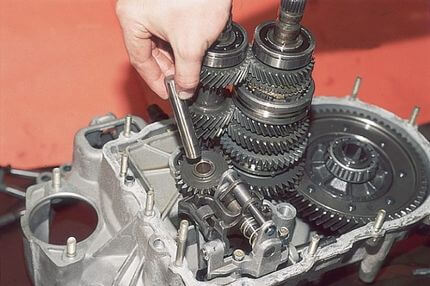
PCS system error
Content
Working areas of sensors
PCS - Pre-Crash Safety System, which is implemented on Toyota and Lexus cars. On cars of other brands, a similar system may have a different name, but their functions are generally similar to each other. The task of the system is to help the driver avoid a collision. This function is implemented by sounding an audible signal and a signal on the dashboard at the moment when pre-crash safety system PCS detects a high probability of a frontal collision between the vehicle and another vehicle. In addition, if a collision cannot be avoided, it forcibly applies the brakes and tightens the seat belts. A malfunction in its work is signaled by a control lamp on the dashboard. in order to understand the possible causes of the PCS error, you need to understand the principle of operation of the entire system.
The principle of operation and features of the PCS system
The operation of the Toyota PCS system is based on the use of scanner sensors. The first one is radar sensorlocated behind the front (radiator) grille. Second - sensor camerainstalled behind the windshield. They emit and receive back electromagnetic waves in the millimeter range, estimating the presence of obstacles in front of the car and the distance to it. Information from them is fed to the central computer, which processes it and makes appropriate decisions.
Scheme of operation of PCS system sensors
The third similar sensor is located in car rear bumper (Rear Pre-Crash Safety System), and is designed to signal the threat of a rear impact. When the system considers a rear collision imminent, it automatically tensions the seat belts and activates the pre-crash front head restraints, which extend forward by 60mm. and up 25 mm.
| Characterization | Description |
| Working distance range | 2-150 meters |
| Relative movement speed | ± 200 km/h |
| Radar working angle | ± 10° (in 0,5° increments) |
| Operating frequency | 10 Hz |
PCS sensor performance
If the PCS determines that a collision or emergency is likely to occur, it will gives a sound and light signal to the driver, after which it must slow down. If this does not happen, and the likelihood of a collision increases, the system automatically activates the brakes and tightens the driver's and front passenger's seat belts. In addition, there is an optimal adjustment of the damping forces on the vehicle's shock absorbers.
In its work, the pre-crash safety system uses the following incoming information:
- the force the driver presses on the brake or accelerator pedal (if there was a press);
- vehicle speed;
- state of the pre-emergency safety system;
- distance and relative speed information between your vehicle and other vehicles or objects.
The system determines emergency braking based on the vehicle's speed and fall, as well as the force with which the driver presses the brake pedal. Similarly, PCS works in case of occurrence side skid of the car.
The PCS is active when the following conditions are met:
- vehicle speed exceeds 30 km/h;
- emergency braking or skid detection;
- the driver and front passenger are wearing seat belts.
Note that PCS can be enabled, disabled, and the collision warning time can be adjusted. In addition, depending on the settings and equipment of the car, the system may or may not have the function of detecting pedestrians, as well as the function of forced braking in front of an obstacle.
PCS error
About an error in the PCS system for the driver indicator lamp on the dashboard signals with the name Check PCS or simply PCS, which has a yellow or orange color (usually they say that the PCS caught fire). There can be many reasons for the failure. This happens after the car's ignition is turned on, and the ECU tests all systems for their performance.
An example of an error indication in the system
Possible breakdowns of the PCS system
Breakdowns in the operation of the Check PCS System can be caused by various reasons. In the following cases, the illuminated lamp will turn off and the system will become available again when normal conditions occur:
- if the radar sensor or camera sensor has become very hot, for example in the sun;
- if the radar sensor or camera sensor is too cold;
- if the radar sensor and the car emblem are covered with dirt;
- if the area on the windshield in front of the sensor camera is blocked by something.
The following situations can also cause errors:
- failure of the fuses in the power supply circuit of the PCS control unit or the brake light circuit;
- oxidation or deterioration of the quality of the contacts in the terminal block of those that are associated with the operation of the pre-crash safety system;
- breaking or breaking the insulation of the control cable from the radar sensor to the vehicle ECU;
- a significant decrease in the level of brake fluid in the system or wear of the brake pads;
- low voltage from the battery, due to which the ECU regards this as a PCS error;
- See also and recalibrate radars.
Methods of solution
The easiest method that can help at the initial stage is to reset the error information in the ECU. This can be done independently by disconnecting the negative terminal from the battery for a few minutes. If this does not help, seek help from an authorized Toyota dealer or qualified and trusted craftsmen. They will reset the error electronically. However, if after a reset the error reappears, you need to look for its cause. To do this, do the following:
- Check the fuse in the PCS power circuit for a blown fuse.
- On a Toyota Land Cruiser, you need to check the power on the 7th pin of the 10-pin connector of the PCS unit.
- Check the contacts on the connectors of the blocks in the legs of the driver and passenger for oxidation.
- Check the seat belt ECU connector under the steering wheel.
- Check the integrity of the cable connected to the front radar (located behind the grille). Often this problem occurs with Toyota Prius cars.
- Check the stop lamp circuit fuse.
- Clean the front radar and grille emblem.
- Check if the front radar has moved. If necessary, it must be calibrated at an authorized Toyota dealer.
- Check the level of brake fluid in the system, as well as the wear of the brake pads.
- In a Toyota Prius, an error signal may occur due to the fact that the original batteries produce an undervoltage. Because of this, the ECU erroneously signals the occurrence of some errors, including in the operation of the PCS.
Additional Information
In order for the PCS system to work properly, you need to take preventive measuresto allow the sensors to function normally. For radar sensor:
An example of the location of the radar sensor
- always keep the sensor and car emblem clean, if necessary, wipe them with a soft cloth;
- do not install any stickers, including transparent ones, on the sensor or emblem;
- do not allow strong blows to the sensor and the radiator grille; in case of damage, immediately contact a specialized workshop for help;
- do not understand the radar sensor;
- do not change the structure or circuit of the sensor, do not cover it with paint;
- replace the sensor or grille only at an authorized Toyota representative or at a service station that has the appropriate licenses;
- do not remove the label from the sensor stating that it complies with the law regarding the radio waves it uses.
For sensor camera:
- always keep the windshield clean;
- do not install an antenna or stick various stickers on the windshield in front of the sensor camera;
- when the windshield opposite the sensor camera is covered with condensate or ice, use the defogging function;
- do not cover the glass opposite the sensor camera with anything, do not install tinting;
- if there are cracks on the windshield, replace it;
- protect the sensor camera from getting wet, intense ultraviolet radiation and strong light;
- do not touch the camera lens;
- protect the camera from strong shocks;
- do not change the position of the camera and do not remove it;
- don't understand the sensor camera;
- do not install devices that emit strong electromagnetic waves near the camera;
- do not change any objects near the sensor camera;
- do not modify car headlights;
- if you need to fix a bulky load on the roof, make sure that it does not interfere with the sensor camera.
PCS system can be forced to turn off. To do this, use the button located under the steering wheel. Shutdown must be done in the following situations:
- when towing your vehicle;
- when your vehicle is towing a trailer or other vehicle;
- when transporting a car on other vehicles - machine or railway platforms, ships, ferries, and so on;
- while lifting the car on an elevator with the possibility of free rotation of the wheels;
- when diagnosing a car on a test bench;
- when balancing wheels;
- in the event that the front bumper and/or radar sensor has been damaged due to an impact (such as an accident);
- when driving a faulty car;
- when driving off-road or adhering to a sporty style;
- with low tire pressure or if the tires are too worn;
- if the car has other tires than those specified in the specifications;
- with chains installed on the wheels;
- when a spare wheel is installed on the car;
- if the vehicle suspension has been modified;
- when loading the car with heavy luggage.
Hack and predictor Aviator
PCS makes your vehicle much safer to operate. Therefore, try to keep it in working condition and keep it constantly on. However, if for some reason it fails, it is not critical. Perform self-diagnosis and fix the problem. In case you were unable to do it yourself, contact an authorized Toyota dealer in your region or qualified craftsmen.
Statistically, people who use seat belt anchor plugs are the most likely to have a PCS problem. The fact is that when the system is triggered, the belts are tightened using built-in motors and switches. However, when you try to unlock the belts, an error appears that is difficult to get rid of in the future. That's why we do not advise you to use plugs for beltsif your car is equipped with a pre-collision system.

